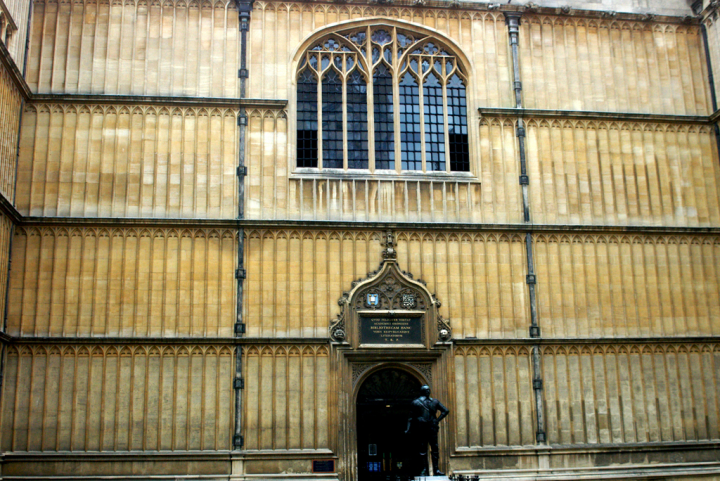
The Bodleian

The big library at Oxford is named after its founder Thomas Bodley, whose admirably-short autobiography may be purchased in the gift shop. We had an excellent guided tour; herewith illustrated notes on the colour of fairy tales and the history of cataloging.
Any of the world’s big old research libraries has a story that’s worth hearing, and the Bodleian’s is too but I’m not going to tell it. If you care about such things go read a book; suffice it to say that it’s big, and old, and fanatically well-cared-for. Also, it’s prettier than most other libraries.
The Bodleian library at Oxford. Top: The interior court. Middle: Detail of the Divinity school ceiling. Bottom: The meeting room behind the Divinity school.
Fairy Stories · Our guide, a retired librarian, was something of a showman. Deep in the subterranean stacks, he took one of the sliding shelves, saying it showed that as Britain’s official copyright deposit library, they had to take more or less everything. He pulled it out, and oh wonder, seven by five feet of late-Nineteenth and early-Twentieth-century fairy-tale collections (and a few scholarly monographs on the Grimms). The lilac, robin’s-egg, and goldenrod pastels of their covers were unfaded, and the gold leaf around the pages unmarred; so unlike the way these books look after years in children’s hands. I wept for my camera, forbidden entry to the stacks.
Cataloging · The tour party was myself, Lauren, John Chelsom, and Peter Flynn; two Ph.D.’s, a third working on his dissertation, and all of us data-structure geeks. The guide got the idea pretty quick and, in one reading room, said “You’ll like this”, pulling out a facsimile of the library’s first-ever catalog. The shelves had been organized by discipline, with a card on the end of each listing its books, organized by author. The first catalog simply aggregated these cards; but then at the end had a list of all the books by author’s name and shelf number. The alphabetization on author’s name did not extend past the first letter.
The next-generation catalog was more conventional, containing all the books in one sequence. But it was given sparkle by annotations in the first librarian’s hand—accessions mostly. The hand was a tiny graceful copperplate italic; Bill our guide told us that that librarian had himself been large, fat, and loud.
Miscellaneous Wonders · The Bodleian has the world’s largest collection of Hebrew manuscripts; its holdings of Arabic, Persian, and various Indian languages are merely excellent. It has Victorian steam-punk machinery for moving books around the stacks. It has miles (probably) of shelves containing the doctoral dissertations, now I suppose mostly lost to memory. One title caught my eye: Books Deposited at the Bodleian for Copyright, 1710-1724. It was from the Seventies, a mighty tome, and I opened it; obviously it had been produced on a Selectric ball typewriter. We walked by shelf after shelf of folio volumes, Chambers’s Dictionary (sic), travelers’ tales, accounts of the doings of the Russian Dukes; my fingers were twitching.
It’s not just a tourist attraction; people were hard at work, everywhere there was room to work. Some year, I’d give my right arm for a Reader’s Card and an undisturbed month. In the meantime, big thanks to John Chelsom and Kerri Poulter for organizing the tour.